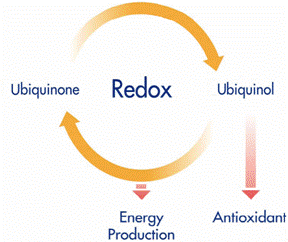Coenzyme Q10 is a vitamin-like nutrient performing two roles vital to
our well-being:
(1) A "Spark" In its essential role in the production of cellular energy. CoQ10 is a relatively large, worm-shaped quinone molecule, called UBIQUINONE because it was found to be ubiquitous (i.e. everywhere)in the body. It was discovered by Fred Crane, Phd. in 1957 in his quest to find the "Missing link" in the mitochondrial energy-producing process.

(2) A "Dampener" as a powerful antioxidant in the mitochondria (cells' energy production factories) and cell membranes. CoQ10 is the only fat-soluble antioxidant synthesized by the body, but production diminishes significantly with age. For some, CoQ10 levels within the heart and kidneys have dropped more than 25% by age 40.

Ubiquinone is converted to ubiquinol. Whether produced in the body, obtained from wholesome, unprocessed foods or supplemented, the body must then convert ubiquinone to ubiquinol.
In order to have electrons to donate to free radicals, antioxidants must be in their reduced form. Ubiquinol (reduced form) is also present in certain foods.
The body's ability to convert ubiquinone (oxidized form of CoQ10) into the necessary active ubiquinol (reduced form of CoQ10) decreases with age and/or with oxidative stress. Under the age of 25, the body is quite capable of converting CoQ10 from its oxidized form to its reduced form;
If you were to break open capsules of the two supplement forms, you would see that. Ubiquinone (the oxidized form of CoQ10) is a bright yellow crystallized powder, and that the ubiquinol (active form) is a much paler whitish yellow.
CoQ10 is present in all tissues in our body
It is associated with lipoproteins
In circulation, 90% of CoQ10 is present in its reduced form(as ubiquinol). The ratio of oxidized to the reduced form in blood may serve as a measure of in vivo oxidative stress. Yamashita S, Yamamoto Y. Simultaneous detection of ubiquinol and ubiquinone in human plasma as a marker of oxidative stress. Anal Biochem. 1997
Recent studies have shown that the level of circulating Ubiquinol (CoQ10-H2) tends to decline in certain disease conditions. E.g. diabetes, liver disease, down syndrome, etc. with the result that the ratio of circulating Ubiquinol to total CoQ10 goes down.
LIM S.C., et al. Oxidative burden in prediabetic and diabetic individuals: evidence from plasma coenzyme Q10, Diabetic Medicine 2006;
Hasegawa, et al. Daily profile of plasma % CoQ10 level, a biomarker of oxidative stress, in patients with diabetes manifesting post prandial hyperglycemia, Acta Diabetol, 2005;
Yamamoto Y, et al. Plasma Ubiquinone to Ubiquinol ratio in patients with hepatitis, cirrhosis, and hepatoma, and in patients treated with percutaneous transluminal coronary reperfusion, BioFactors, 1999
Concentrations vary from tissue to tissue, but CoQ10 is more concentrated in areas with high rates of metabolic activity and high energy demands
The heart has the highest CoQ10 concentration. Followed by the liver, kidneys, spleen and pancreas
The oxidized vs. reduced forms of CoQ10 (i.e. ubiquinone vs. ubiquinol) also varies from tissue to tissue. Those with high aerobic activity generally contain higher amounts of ubiquinone (the oxidized form);
Heart muscle is packed with mitochondria (~¼ the volume of heart cells). Heart expands/contracts 100,000 times/day requiring lots of energy and therefore needs lots of CoQ10.